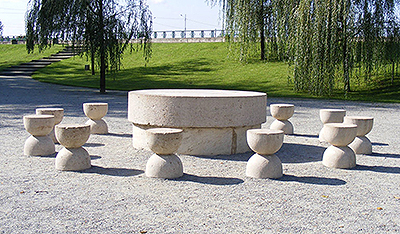The Table of Silence is one of three sculptures which make up Constantin Brancusi's monument ensemble in the central park at Targu Jiu in Romania. Commissioned in 1935 and completed three years later, the sculptures pay homage to the Romanian soldiers who fought in the first world war.
Considered as one of the greatest examples of outdoor sculpture of the 20th century the ensemble is completed by the Gate of the Kiss and the Endless Column. The Table of the Silence sees a large circular stone table surrounded by twelve hourglass seats, an arrangement which can draw comparisons to the Last Supper and is sometimes referred to as the Apostles Table.
The circular table is a representation of where the soldiers would have gathered, perhaps around a family table, prior to battle. It is comprised of two blocks made from limestone. The first stone has a diameter of 200cm, while the larger stone placed on top measures in with a diameter of 215cm. The hourglass chairs are not actually positioned right next to the table and symbolise time disposed. It suggests the silence of this last gathering before the looming conflict and the awareness it may be their last. Brancusi designed a further 30 stone stools in order to flank the walkway from the Table of Silence to the Gate of the Kiss and these stools symbolise those who participate without any implications.
Although Constantin Brancusi was living in Paris at the time of the commission, it was one he was happy to take on, reportedly refusing to accept any payment for his work. The commission of the monument was made by the National League of Gorj Women with the aim of honouring the brave soldiers who defended Targu Jiu in World War One. The work was completed in 1938 and is now a must see visit for tourists. Brancusi had moved to Targu Jui at the age of 9 where he then spent most of his childhood.
The monument came under threat during the Communist era in Romania but was fortunately saved from destruction for future generations to admire. Brancusi is considered a pioneer of modern abstract sculpture and helped inspire a minimalist approach to art from the 1960s and beyond, influencing artists like Henry Moore. One of his own influences was Auguste Rodin, for who he worked as a studio assistant in 1907. Called the Patriarch of modern sculpture, The Table of Silence shows the elegant, clean lines of Constantin Brancusi's sculpting, a craft he mastered using many different materials including stone.




